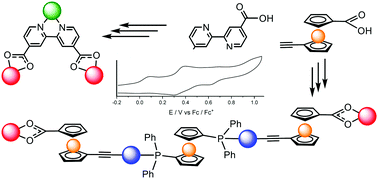Abstract
A series of homo- and hetero-nuclear, bi- and trimetallic compounds are accessible using polyfunctional linkers with carboxylic acid and alkynyl or pyridyl donor combinations. This versatile approach affords reaction at a specific donor site in each case, to accommodate both ruthenium(II) or osmium(II) units and also rhenium and gold centres. Due to the orientation of the nitrogen donors of the bipyridyl moiety in 2,2′-bipyridine-4,4′-dicarboxylic acid, the metal addition must be performed in a certain sequence due to steric considerations. One example was investigated crystallographically to add to the spectroscopic and analytical characterisation performed for all complexes. Photophysical investigations reveal the effect of incorporating second or third row transition metal centres. This approach was expanded through the use of a linker bearing both carboxylic acid and alkynyl functionalities, 1,1′-ethynylferrocene carboxylic acid. This allows initial coordination of the carboxylate donors to be followed by the formation of either an acetylide or a vinyl bridge to another metal, providing access to heterotrimetallic (FeRuOs and FeRuAu) compounds as well as a heteroheptametallic Fe3Ru2Au2 example. Preliminary electrochemical studies were performed on the latter compound.



 Please wait while we load your content...
Please wait while we load your content...